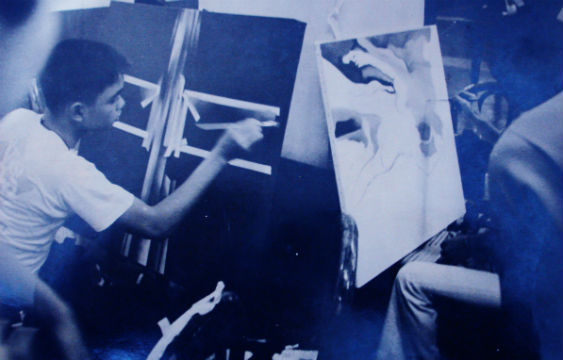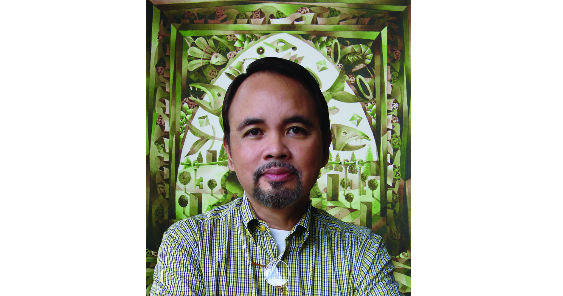by Jose Tence Ruiz
It was the mid 70; 1976 to be precise. This most talented and disciplined of my friends in the painting department looked totally out of place in the studio. He wore an immaculate starched white shirt, pressed dark blue slacks, shiny black sandals, had his hair combed with soft bangs and looked like he was about to enter a lecture in pre-med, not fine arts. A total anti-boho, as today’s kids would describe, but yes, this was Heraclio Basilio then, and until the last, neat, reliable, and in total control.
Eros radiated an inborn feel for painting and drawing. But he never let this scatter all over the place. He cultivated relaxed but unwavering focus that translated into a voice that, most would concede, in a 70s context, yearned for the deconstruction and draftsmanly analytics that Vicente Manansala looked for in what we then nicknamed ‘synthetic cubism’. A child of the nascent nationalism of this epoch, Eros appropriated this controlled, diagnostic vision and, in a spare palette of hooker’s greens and earthen purples, plotted out paintings of Moriones, Jeepneys, church facades and nativist motifs. His eye for composition and color balance won him dozens of awards as an undergrad, culminating in the 1976 Benavides Civic Award for Outstanding Achievement in Art, which was given to only one graduate per batch.

A young Eros Basilio participates in a competition held in the University of the East
Eros, myself and 4 others, Ramoncito Ocampo Cruz, Taloy San Diego, Neptali Intia and Ramon Agapay kicked off an ambitious climb into the ranks of professional artists with a group show called Hidden Lines, at the Hidalgo Gallery in Makati in 1976. Thereafter, we dreamed of evolving into practitioners worthy of our Saturday group idols Manansala, HR Ocampo, Cesar Legaspi, Malang, Olazo, Ang Kuikok, Abueva, Castrillo and many others. The 70s were a contested, repressed but seminal era under Imelda’s hothoused True, Good and the Beautiful regime, and 20-somethings indulged in dreaming of success, of patronage, of creative freedom, of originality soaring to the topospheres of imagination: fancies that burned in our chests as we entered the next few decades.
Soon after finishing fine arts, Eros pragmatically found work as a designer, as the truth of the struggle to make it in the arts began to unfold for us. He had gotten married, had a lovely daughter, but, in a first tragic twist, separated from his wife. Taking charge as a single parent, Eros deferred his Fine Art dreams and found regular sustained wherewithal as a designer,
initially at a fledgling TV Cable channel, then for small design boutiques and studios until he entered, arguably, one of the largest Ad Agencies in Manila, McCann Erickson. Here he stayed, reliable, comfortably paid and capable of converting his visual acumen into design that satisfied many a corporate brief. His colleagues in advertising would swear to his clockwork dependability and quiet but sure knack for delivering visual solutions. He may not have spent these years exhibiting paintings in public, but his designs, specially for Brand Logos, reached a mass audience above and beyond his earlier ambitions. Anyone familiar with the brand IDs of Ayala Center, Globe Handyphones, Ballet Philippines, UP-Ayala Techno-Hub, Isuzu Crosswind, SMX Convention Center and, most famous of all, San Mig Light will have witnessed Eros’ gift for pictograph making that moved the spirit.
Eros spent a prolific quarter century in corporate design, raising his daughter, abiding his parental obligations, generally trading his skills and acumen for reliable income. But after 25 years, he ached for the personal, solitary path that he had once encountered in painting. He started to again do acrylics on paper and canvas, for himself primarily, to exhibit, to explore his inner leanings, far from obligations and contractors, art directors and corporate requisites. He eventually retired from McCann Erickson in 2010 and sought to rekindle the visual sparks that he had begun to stoke as a painting major in the idealistic but Marcosian 70s.
For all his good looks and genuinely benign character, Eros never remarried, much less re-entered into a relationship. His abiding love for family, his mother and brother, his daughter, sufficed. He seemed to have kept this part of his psyche unburdened, even preserved, for all the emotive revery that the next 6 years would open up to. He applied his meticulous draftsmanship, the muted palette of oxide purples and chrome and hooker’s greens, to imaginings of the feminine, of the chthonic, of the idyllic and botanical, of the poetic and flighty, of the surreal and still, of a tranquil inner landscape and indigenous pattern making that he may have been nurturing in his private spaces all throughout the decades he delivered on his very public commitments. If there was another consistent thread that these works would re-attach, it was that here was a place he could control, fashion, build without the proverbial hot breath behind his shoulder. And he began again to reconstruct this vista, one cubist triangle at a time, layered, caressed, crafted, measured and unfolding according to his timing, his pace, his unhurried re-enactment.

Eros Basilio (left) and fellow artist Jose Tence Ruiz (right)
Unheralded, intense pain and illness ambushed Eros amidst this purposeful return to reverie. The deep loneliness of losing his beloved brother Anlex wore away at his joy from another direction. Eros had his world under control, or it wasn’t his world. You could rely on this, and the chaotic disruptions that tore into his dreams must have moaned with a grating, manic despair. But he would not let despair suffocate him in its emphysemic grip. Up to end, Eros fought to be in charge. Life, like his immaculate shirts in the dusty UST fine arts studios, would have to be neat, immaculate and rise above all this, or not at all.
—-
Eros Exeunt, an exhibit tribute to Eros Basilio, will be held from July 22 to 27 at NOVA Gallery, Warehouse 12A, La Fuerza Compound, Don Chino Roces Ave., Makati City.









